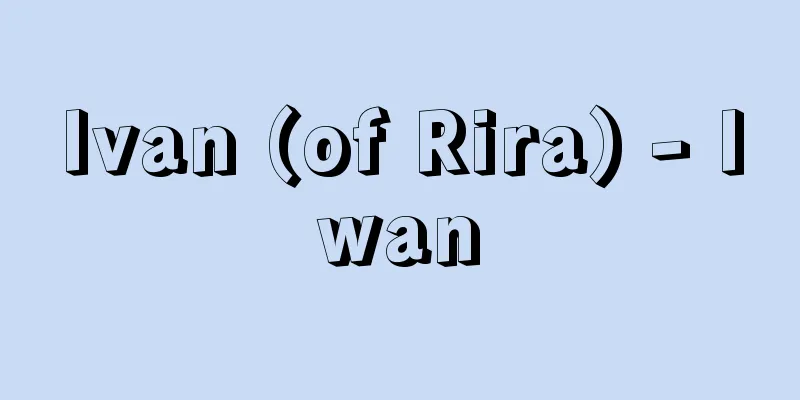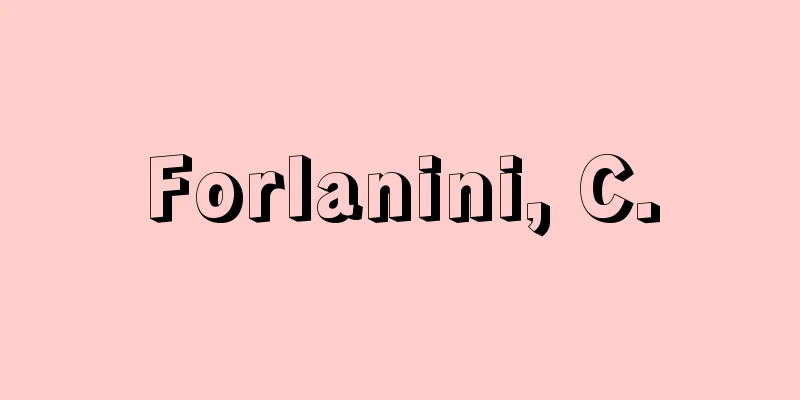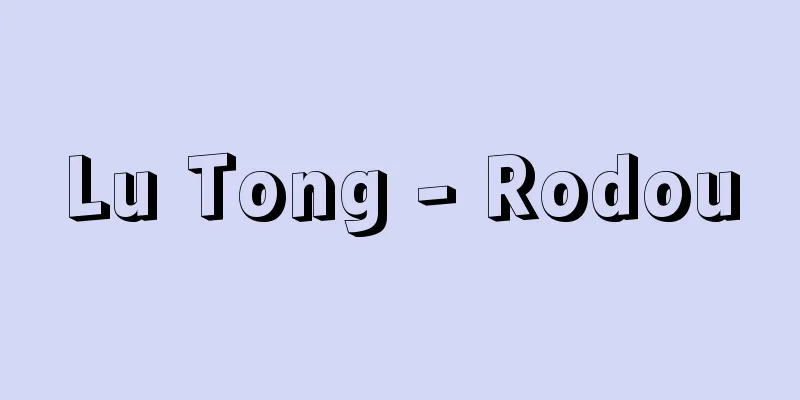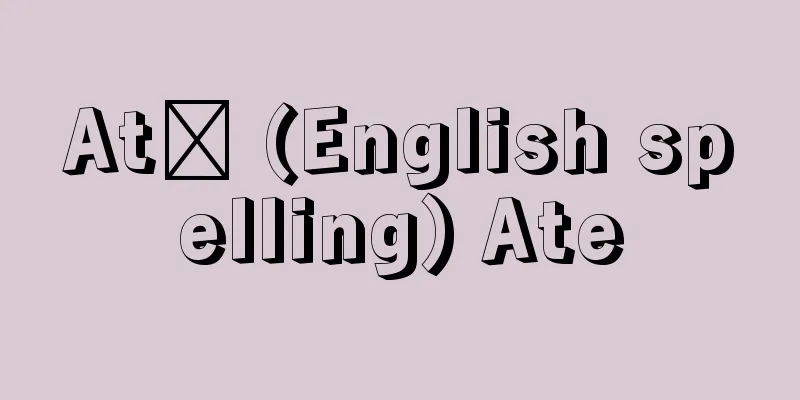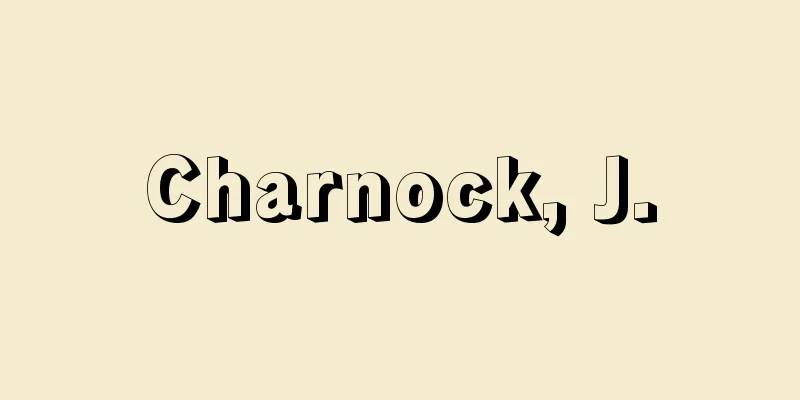Grave - Haka

|
A place where a body or bones are buried. It can also refer only to stone monuments erected on top of them. A grave is a place where the body or bones are disposed of, as well as a place or facility for holding after-death rites for the deceased. However, places where bodies are disposed of in cremation are called crematoria or crematoria and are distinguished from graves, while memorial tablet halls and mausoleums set up in temples, Buddhist altars in homes, ossuaries and memorial towers are not generally called graves, although they are used for after-death rites. Graves reflect the overall culture of a country or ethnic group, including its views on life and the afterlife, and they change over time, differ by class and religion, and can change in complex ways due to the influence of foreign cultures. [Shoji Inoguchi] Japanese GravesThe word hafu (to bury), which means to dispose of a corpse, is said to have the same root as hafuru (to throw away). The etymology alone does not clarify the age, and it is thought that even before historical times, people would have taken care to cover the body with soil or move it to an inconspicuous place, but in the belief in the soul, the body or bones were not given much importance, and only the soul was respected as immortal, so no memorials were set up for the deceased at the site of the disposal of the body. Then, when the Kofun culture was introduced from the continent and some upper-class rulers began to build huge kofun (burial mounds), there was a growing trend to respect not only the spirits of the dead, but also the bodies and memorials. Cremation is said to have been introduced to Japan with Buddhism, which also taught respect for the individual, which is thought to have led to the emphasis on remains. In Buddhism, although it is believed that the spirits of the dead leave for the other side of the earth and never return to this world, memorial towers were built to commemorate the spirits of the dead. The stone monument tombs commonly seen today are a combination of this memorial tower and a small stone placed as a marker on top of the body of the dead. In contrast to the single grave system, where a stone monument is erected after burial, there is a system called the double grave system. This system has two graves for each deceased: a burial grave where the body is buried and a pilgrimage grave where a stone monument is erected and the deceased is enshrined. It is most prevalent in the Kinki region, but is also found throughout Honshu. The body is buried as unclean, and only the spirit inside is enshrined as an ancestor. The custom of erecting stone monuments for common people dates back to the end of the Middle Ages even in the advanced areas of Kinki, and it can be said that it became widespread around the early modern period, so the time when the double grave system, which corresponds to the stone monument, emerged can be roughly estimated. In areas with the double grave system, the burial grave is sometimes built outside the village border, on an isolated island, or in the shade of a mountain, and there are also cases where the two graves are built next to each other. The double grave system is based on burial, so it has been declining in recent years with the spread of cremation. Looking at cemeteries in various regions, we can see that there are now many collective graveyards, but originally each family had their own graveyard, or branch families established graves near the main family to form clan graves. Since it was against the common interest for each household to establish graveyards here and there and to designate them all as tax-free land, the communalization of cemeteries was often promoted after the Meiji period. There were also family graves set up within the family's own land. In large cities, burials are prohibited by ordinance, and of course it is not desirable to bury someone close to a house for sanitary reasons. In Okinawa and the Amami Islands, exposed burials (leaving the coffin on the ground) and cave burials are practiced, and there is also a scattered custom of washing the bones a dozen years after the burial. The huge Monchu (family graves) called Kikko Tombs on the main island of Okinawa are probably a combination of cave burials and Chinese-style tombs. It is known that Prince Shotoku built his own grave while still alive, and in Buddhism this is known as gyakushu, which became popular among some people. Whether it is a gyakushu or a couple's grave, the posthumous name of the living person is inscribed in vermilion. Graves of people who have died on the road or who have no descendants to worship them are called unrelated graves, and are organized as shared graves or a tower to honor all the souls of the three worlds is built all together. For the graves of children, in the hope of their reincarnation, no formal graves are generally created, and instead, a stone Jizo statue is placed on top of the burial site. From around the early modern period, it became popular for common people to erect stone monuments, and the techniques for carving them also developed. The work of stone masons, known as sculptors, gradually began to use harder stones and came to be known as hard stone carving. The shape of stone monuments developed from memorial towers, and in the early days, there were many multi-storeyed pagodas, pagodas, pagodas with treasure boxes, and five-ringed towers, but they gradually unified from egg towers, Buddha statues, and sotoba shapes to square stone shapes. Some people say that the feng shui of a grave is good or bad, but there is no basis for this. The time when stone monuments are erected is often the 3rd, 7th, or 13th anniversary of a person's death, but it varies depending on the circumstances of each family. There are also individual graves, couple graves, and ancestral graves. As the population becomes more concentrated in large cities and land use becomes more advanced, cemetery regulations become necessary as part of urban planning, and legal restrictions are in place, such as requiring permission from the governor to operate. From the perspective of the landscape, park cemeteries have been created, and from the perspective of advanced land use, cemetery complexes and ossuaries have been created to create three-dimensional structures, and there are also many unique stone monuments. There are also graves (ossuaries) for pet animals. [Shoji Inoguchi] Graves of the WorldTombs are deeply connected to each society's funeral customs and views of the afterlife. However, there are many other factors that affect tombs and their customs, ranging from a society's natural environment and form of livelihood to the age and sex of the person buried at the time of death, and their social status and rank. For this reason, there is remarkable diversity in tomb forms and customs around the world. The oldest example of corpse disposal accompanied by the concept of a grave is seen in the Middle Paleolithic period in Europe. In the Moustiers Cave in France, extension and flexed burials were practiced, and grave goods were also added. At the La Ferrassie site in France, four human skeletons, one adult male and one child, were discovered, surrounded by grave goods such as stone tools and animal bones, clearly showing signs of artificial burial. This suggests that humans at this time had a somewhat vague concept of graves and the afterlife. In the late Paleolithic period, burial methods and grave goods became more complex. Bodies were buried in land containing red soil, or red soil was applied to the bodies. There also seems to have been a kind of skull worship, where the skull was separated from the body and buried separately. Furthermore, stones began to be used in tombs, with stones placed on the hands and feet of the body or to protect the body with stones. This took on a unique form as megalithic culture in Neolithic Europe. Examples are tombs using megaliths, such as the so-called dolmens and stone circles. However, a major turning point in the evolution of tombs was the stage of settlement that accompanied the transition to an agricultural society. Communal cemeteries were already being constructed in Neolithic Egypt. It is believed that by settling down, humans acquired the permanent tombs we see today. It was also at this stage that, with the development of dynasties, huge tombs for the ruling class began to appear. Examples include the pyramids of Egypt, the royal tombs of China, and the imperial tombs of Japan. These magnificent royal tombs, with their size, sophistication, and gorgeous grave goods and interior decorations, suggest the existence of powerful royal authority and an advanced technological civilization. Another new feature is that these royal tombs were constructed with the aim of preserving the bodies and the tombs themselves for a long period of time. Today's tombs and their customs vary widely from civilized societies to traditional or primitive societies. Generally, the burial mounds, in which the body is buried in the ground and covered with soil, and the installation of a grave marker at the burial site are characteristic of major religions such as Buddhism, Christianity, and Islam. However, in traditional and primitive societies, the tombs are extremely diverse. The burial method of placing the body on a platform or tree, called a platform burial or tree burial, is seen in various places in North and Central Asia, as well as in eastern Indonesia, Melanesia, Australia, and America, and may also be considered a type of tomb. The burial method of burying the body inside a house is scattered throughout Africa, Indonesia, and the Amazon region of South America, and the custom of building a hut on top of the tomb, which is said to be an advanced form of this, is also widely distributed in the same region, Australia, North Asia, America, and Southeast Asia. The niche tomb, a type of cave burial, is found throughout Africa and Australia. However, while it can be said that some kind of ritual is performed when disposing of a corpse, a grave is not necessarily directly connected to the disposal of the corpse. Sky burial, which is practiced among Tibetan Buddhists and Indian Parsis, and boat burial, which is practiced in Melanesia and Polynesia, do not have a grave in the strict sense. The same can be said for Hindus, who dispose of the ashes in sacred rivers after cremation. The above can be said to be abandonment of the corpse, but in so-called traditional and primitive societies, there are many areas that do not have the cemeteries and grave markers that we generally imagine, and in some cases, a certain area where the dead are buried is connected to the vague idea of a grave. Where a grave is built is closely related to a society's view of the afterlife and the world. Generally, tree burials and burials on platforms are associated with the view of the afterlife in the upper direction, such as the sky or the sun, and are said to have the meaning of making it easier for the souls of the dead to go to the afterlife. The "Feng Shui" belief seen in China and Korea is a belief that happiness or misfortune is determined by the direction of the graveyard and the house. It is believed that if the grave is built in a good direction, the dead will be grateful and will bestow good fortune on their descendants, but if it is built in a bad direction, they will be angry and bring misfortune. Japanese tomb physiognomy is a similar belief. In Bali, Indonesia, the "mountain side" is generally considered to be a sacred direction, and the "sea side" is considered to be an unclean direction. For this reason, in Balinese villages, temples that worship the spirits of the dead who are being buried are located on the "sea side," opposed to temples that worship ancient ancestors and village founders on the "mountain side." In some cases, as in China, the arrangement of grave markers reflects social organization. [Takuma Shirakawa] "Japanese Funerals" by Shoji Inokuchi (1977, Chikuma Shobo) " "The Origin of Funeral Customs" by Taro Obayashi (1965, Kadokawa Shoten) " "Cemeteries" edited by Koichi Mori (1975, Shakai Shisosha) [Reference items] | | | | |Source: Shogakukan Encyclopedia Nipponica About Encyclopedia Nipponica Information | Legend |
|
遺体や遺骨を葬ってある場所。またその上に建てた石碑類だけをいうこともある。墓は遺体や遺骨を処理する場所であるとともに、死者のために死後の祭りをするための場所や設備である。ただし火葬における遺体処理場は、火葬場とか焼き場とかいって墓とは区別しており、寺院などに設けた位牌(いはい)堂や霊廟(れいびょう)、家庭で祀(まつ)る仏壇、納骨堂や供養塔の類は、死後の祭りのためのものであるが一般に墓とはよばれていない。墓はその国、その民族の生命観、死後観など文化全体のありようを反映するもので、しかも時代によって変遷し、階層や宗教によって違い、外来文化の影響によって複雑に変化することがある。 [井之口章次] 日本の墓遺体を処理するという意味の葬(はふ)るという語は、放(はふ)る(投げ捨てる)と同根だといわれている。語源説だけでは年代が明らかでなく、歴史時代以前でも土をかけるとか、目につかない場所に移すとかの配慮はあったろうと思われるが、霊魂信仰では遺体や遺骨を重視せず、霊魂だけを不滅のものとして尊重したから、遺体処理の場所に死者に関する記念物を設けることはなかった。そこへ大陸から古墳文化が伝来し、一部上流の支配者たちが巨大な古墳を築造するようになると、死者の霊ばかりでなく遺体や記念物をも尊重する気風が強くなってきた。 火葬は仏教とともに伝来したとされているが、仏教はまた個人の尊重を教え、それが遺骨の重視につながったことが考えられる。仏教では、死者の霊が十万億土の彼岸(ひがん)に去って、ふたたび現世(げんぜ)に立ち戻ることがないとしながらも、死者の霊を供養するための供養塔を設けることとした。現在一般にみられる石碑墓は、死者を埋葬した上に目印としてのせる小石と、この供養塔との合体したものである。 埋葬した上に石碑を建てて祀る単墓制に対して、両墓制といわれるものがある。1人の死者に関して、死体を埋(うず)める埋(う)め墓と、石碑を建てて祀る詣(まい)り墓とを二重にもつ墓制で、近畿地方にもっとも濃密に分布し、本州各地に点在する。遺体はけがれたものとして葬り、その中の霊だけを先祖として祀る。庶民のために石碑を建てる習俗は、近畿の先進地帯でも中世末からのことであり、広く普及したのは近世の中ごろとみてよいから、石碑と対応する両墓制発生の時期はほぼ推定することができる。両墓制の地帯では、埋め墓を村境の外に設けたり、離れ島や山かげにつくる所があり、また両墓を隣接して設ける例もある。両墓制は土葬を基本としているので、近年火葬の普及とともに減少の傾向をたどっている。 各地の墓地をみると、いまは集団墓地が多くなったが、もとは家ごとに墓地をもち、あるいは分家が本家のそばに墓を設けて同族墓を形成しているものが多かった。各戸がかってにあちこちに墓地を設け、すべてを免租地に指定することは共同の利益に反するので、明治時代以後しばしば墓地の共同化が進められた。自家の宅地内に墓を設ける屋敷墓もあった。大都市では条例で土葬は禁止されており、もちろん衛生上も住宅に近接して土葬することは好ましくない。沖縄や奄美(あまみ)の島々には曝葬(ばくそう)(棺を地上に放置する)や洞窟(どうくつ)葬が行われ、また葬後十数年ののち洗骨(せんこつ)する風習も点在する。沖縄本島で亀甲(きっこう)墓とよばれる巨大な門中(もんちゅう)(同族)墓は洞窟葬と中国式の墓との結合したものであろう。生前に自分の墓をつくることは、聖徳太子が自ら墓所を築いたことなどが知られており、仏教では逆修(ぎゃくしゅ)とよんで一部に流行した。逆修でも夫婦(めおと)墓でも、生きている者の法名(ほうみょう)には朱を入れておく。行き倒れや、祀りをしてくれる子孫のない人の墓は無縁墓とよび、寄せ墓をして整理したり、一括して三界万霊塔を建てておく。小児の墓は、生まれ変わることを期待して一般に正式な墓を設けず、埋めた上に石地蔵をのせたりした。 近世の中ごろから庶民も石碑を建てることが流行し、石碑を刻む技術も発達した。石工(いしく)のうちの彫刻工の仕事で、しだいに堅い石材を使うようになって堅物細工とよばれている。石碑の形は供養塔から発展したので、初期には層塔、宝塔、宝篋印塔(ほうきょういんとう)、五輪塔などが多く、卵塔(らんとう)形、仏像形、卒塔婆(そとば)形からしだいに角石形に統一されてきた。世間には墓相のよしあしなどをいう者もあるが、これにはなんの根拠もない。石碑を建てる時期は、3年・7年・13年目などの年忌のおりが多いが、家々の事情によって一定しない。また、個人墓、夫婦墓、先祖代々の墓などがある。 大都市に人口が集中し土地利用が高度化すると、都市計画の一環としての墓地規制が必要になり、経営には知事の許可を必要とするなど法的にも規制が定められている。景観のうえからは公園墓地、土地の高度利用のうえからは墓地団地や納骨堂など立体化が図られ、石碑についても個性的なものが多くなった。別に愛玩(あいがん)動物の墓(納骨堂)もある。 [井之口章次] 世界の墓墓は、それぞれの社会の葬制や他界観と深くかかわっている。しかしそれ以外にも、その社会の自然環境や生業形態から、埋葬される人間の死亡時の年齢や性別、社会的地位や身分まで、墓やその習俗に影響する要因は多様である。そのため、墓にかかわる形態や習俗には、世界各地で顕著な多様性がみられる。 墓という観念を伴った死体処理の最古のものは、ヨーロッパの旧石器時代中期にみられる。フランスのムスティエ洞窟では、伸展葬や屈葬が行われ、副葬品も添えられていた。同じくフランスのラ・フェラシー遺跡では、成人男女と小児計四体の人骨が発見され、その周囲に石器や動物骨などの副葬品も置かれており、人為的に埋葬された跡が明らかである。この時期の人類がある程度の漠然とした墓の観念や他界観をもっていたことが、そこからうかがわれる。 旧石器時代後期に入ると、埋葬法も副葬品も複雑化していく。赤土を含んだ土地に遺体を埋葬したり、遺体に赤土が塗られたり、また遺体から頭蓋骨(とうがいこつ)を切り離し別に埋葬するなど一種の頭蓋骨崇拝も存在したようである。さらに遺体の手足に石をのせたり、遺体を石で保護するなど墓に石が使用され始めた。これは、新石器時代のヨーロッパにおいて巨石文化として独自の形態をとるようになる。いわゆるドルメン、ストーン・サークルなどの巨石を用いた墓がその例である。 しかし墓の変遷をみるうえで大きな転換点となるのは、農耕社会への移行に伴う定住化の段階であろう。新石器時代のエジプトではすでに共同墓地が造営されていた。定住化によって人類は現在みられるような恒久的な墓を獲得したと思われる。さらに王朝の発達によって、支配者層の巨大墳墓が出現するようになるのもこの段階である。エジプトのピラミッド、中国の王墓、日本の天皇陵などがその例である。これら豪壮な王墓は、その巨大さ、精巧さ、華麗な副葬品や内部装飾から、強力な王権や高度な技術文明の存在をうかがわせるものである。またこれらの王墓が遺体や墓そのものの長期の保存を目的として造営されたことも新たな特徴の一つである。 今日の墓の形態やその習俗は、文明社会から伝統社会あるいは未開社会とよばれる地域に至るまで多種多様である。一般に、遺体を地中に埋めて土を盛った塚や、埋葬した場所に墓標を設ける形式は、仏教、キリスト教、イスラム教などの大宗教に特徴的である。だが伝統社会や未開社会では、墓の形態はきわめて多様である。台や木の上に死体を置く台上葬や樹葬とよばれる葬法は、北アジアや中央アジアをはじめ、インドネシア東部、メラネシア、オーストラリア、アメリカなど各地にみられるが、これも墓の一種とみなせるかもしれない。また、遺体を家屋の内部に葬る形態は、アフリカ、インドネシア、南米のアマゾン地域に点在し、さらにその発展形態ともいわれる墓の上に小屋を建てる習俗も、同地域をはじめ、オーストラリア、北アジア、アメリカ、東南アジアなどに広く分布している。洞窟葬の一種である壁龕(へきがん)墓の形態は、アフリカ、オーストラリアの各地に分布している。 しかしながら、死体処理に際してなんらかの儀礼が行われることが人類一般に普遍的ともいえるのに対して、墓はかならずしも死体処理と直結しているわけではない。チベット仏教やインドのパールシー教徒の間で行われている鳥葬や、メラネシア、ポリネシアで行われている舟葬は、厳密な意味での墓をもたない。火葬ののち遺骨を神聖な川に流すヒンドゥー教徒の場合も同様である。以上は死体放棄ともいえるものであるが、いわゆる伝統社会や未開社会においては、一般にわれわれが想起する墓地や墓標をもたない地域も多く、死者が葬られるある区域が漠然とした墓の観念につながっている場合もある。 墓がどこにつくられるかは、その社会の他界観や世界観と密接に関係してくる。一般に樹葬や台上葬は、天上や太陽といった上方他界観と関連し、死者の魂があの世に行きやすいようにという意味をもつといわれる。中国や韓国にみられる「風水」信仰は、墓地と家屋の方向によって幸・不幸が左右されるとする信仰である。よい方角に墓をつくれば、死者は感謝し、その子孫に幸運を授けるが、悪い方角だと怒って不幸をもたらすと考えられている。日本の墓相もこれに類似する信仰である。インドネシアのバリ島では一般に「山側」が神聖な方向、「海側」が不浄な方向とされている。そのため、バリの村落では、埋葬中の死者の霊を祀(まつ)る寺院は「海側」に位置しており、「山側」にある古い祖先や村の始祖を祀る寺院と対置している。また中国のように墓標の配列様式が社会組織を反映する場合もある。 [白川琢磨] 『井之口章次著『日本の葬式』(1977・筑摩書房)』▽『大林太良著『葬制の起源』(1965・角川書店)』▽『森浩一編『墓地』(1975・社会思想社)』 [参照項目] | | | | |出典 小学館 日本大百科全書(ニッポニカ)日本大百科全書(ニッポニカ)について 情報 | 凡例 |
>>: Haka - Haka (English spelling)
Recommend
Orange (English spelling)
A city just west of Newark, New Jersey, United Sta...
August, Z.
From 1561 to 1565, he studied Roman law at the Un...
Morgan, JJB (English spelling) MorganJJB
… [Takenori Noguchi] [Children's lies] Childr...
Hymenophyllaceae
...Sometimes used for bonsai. [Hymenophyllaceae] ...
Ocean Anniversary - Umi no Kinenbi
→Marine Day Source: Shogakukan Encyclopedia Nippo...
Erkel F.
…The brothers Joseph and Michael Haydn, KD von Di...
Kick Law
One of the laws of crushing states that the energy...
Cocaine - English spelling: cocaine
An alkaloid found in the leaves of the coca plant...
Kannoushi - Envoy for agricultural promotion
From ancient times to the Middle Ages, envoys were...
Ako [city] - Ako
The city is located in the southwestern corner of ...
Bow and harp
A type of koto. See the entry for "bow" ...
Ladino clover
A perennial legume cultivated for animal feed. It ...
Mustard Seed Garden Paintings
…A Chinese painting guidebook from the Qing dynas...
Five tones - Gosei
A term in musical scale theory. It originated in ...
Yonosuke Natori
Photographer and photo editor. Born in Takanawa, ...
